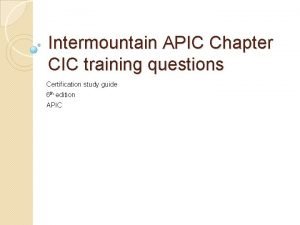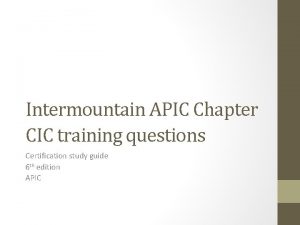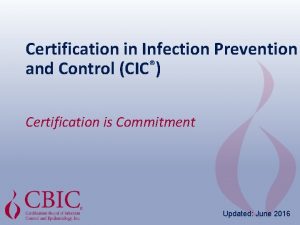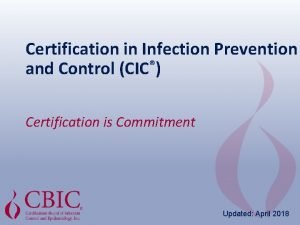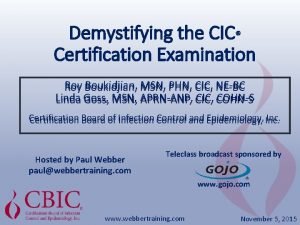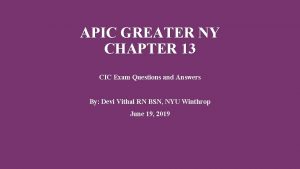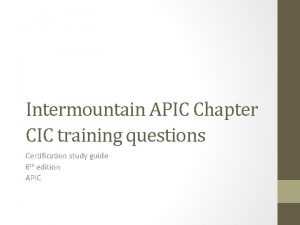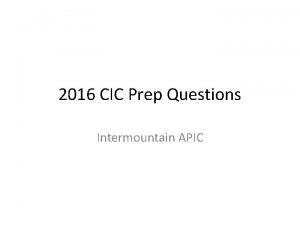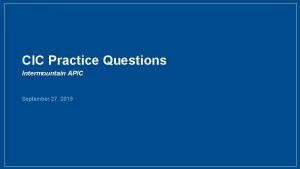INTERMOUNTAIN APIC CHAPTER CIC TRAINING QUESTIONS Certification study







- Slides: 7

INTERMOUNTAIN APIC CHAPTER CIC TRAINING QUESTIONS Certification study guide 6 th edition APIC

QUESTION 1 A. B. C. D. A patient who was hospitalized for 2 days calls 3 days after discharge complaining that he has developed healthcare associated scabies due to his recent inpatient stay. The IP knows that his scabies infestation is not healthcareassociated because: Scabies is only transmitted through contaminated linens, and the IP confirmed that all linens the patient came into contact with had been properly laundered. The incubation period for scabies is longer than 5 days. The incubation period for scabies is shorter than 3 days. Scabies is only transmitted through direct contact and none of the healthcare personnel who cared for the patient are infested.

ANSWER: B - THE INCUBATION PERIOD FOR SCABIES IS LONGER THAN 5 DAYS. The incubation period for scabies may be as short as 10 days but is typically 4 -6 weeks. Therefore, the patient could not have acquired scabies during the hospital stay because, based on the incubation period, he would need to have been exposed at least 5 days before he was admitted. APIC Study Guide 6 th edition: CH 3, P 55, Q 9 Reference: APIC text, 4 th Edition, Chapter 99 Parasites

QUESTION 2 The IP has been benchmarking her data to other facilities performing similar activates for a period of time. The IP should analyze the entire process to ensure that which of the following conditions are met? 1) Standardized definitions are used consistently 2) Overall rates are used to accurately track trends over time. 3) Adequate training of personnel to collect, store, manage, and analyze data. 4) Data are calculated using the same methodology as nationally validated system. A. B. C. D. 1, 2, 3, 4. 1, 2, 4.

ANSWER: C - 1, 3, 4 To accurately trend surveillance data over time within a facility or compare rates between facilities, surveillance criteria (i. e, case definitions) must be consistently used to determine the presence of an HAI, occurrence of an event, or compliance with a process. Rates, rather than raw numbers, must be used to accurately track trends over time. Personnel who are responsible for collecting and managing surveillance data must have adequate training in reviewing medical records, interpreting clinical notes, applying standardized criteria for identifying cases, using appropriate statistical and risk adjustment methods, and using computer tool and technology (especially electronic records, spreadsheets, and databases) to collect, store, manage, and analyze data. Whenever possible, data should be expressed as rates or ratios that are calculated using the same methodology as nationally validated surveillance system. This allows an organization to compare its rates with another organization or recognized benchmark. APIC Study Guide 6 th edition: CH 4, P 86, Q 10 Reference: APIC text, 4 th Edition, Chapter 11 - Surveillance

QUESTION 3 The U. S. Pharmacopoeia (USP) recommends that multidose vials be disposed of: A. 14 days after opening. B. 30 days after opening. C. 28 days after opening. D. When all the medication has been used.

ANSWER: C - 28 DAYS AFTER OPENING 28 days after opening, a multidose vial is a vial of liquid medication intended for parenteral administration (injection or infusion) that contains more than one dose of medication. Multidose vials are labeled as such by the manufacturer and typically contain an antimicrobial preservative to help prevent the growth of bacteria. The preservative has no effect on viruses and does not protect against contamination when healthcare personnel fail to follow safe injection practices. USP standard <797> requires that a multidose vial be discarded within 28 days after its first opening in accordance with USP chapter <51> unless specified by the manufacturer. The CDC recommended refrigerating the vial after opening if recommended by the manufacturer, cleaning the rubber diaphragm of the vial with alcohol before inserting a device into the via, using a sterile device each time a vial is accessed, and avoiding touch contamination of the device before penetrating the rubber diaphragm. The multidose vial should be discarded when empty, when suspected or visible contamination occurs, or when the manufacturer’s stated expiration date is reached. Medications packaged as multidose should be assigned to a single patient whenever possible. APIC Study Guide 6 th edition: CH 5, P 120, Q 9 Reference: APIC text, 4 th Edition, Chapter 110 – Pharmacy Services
